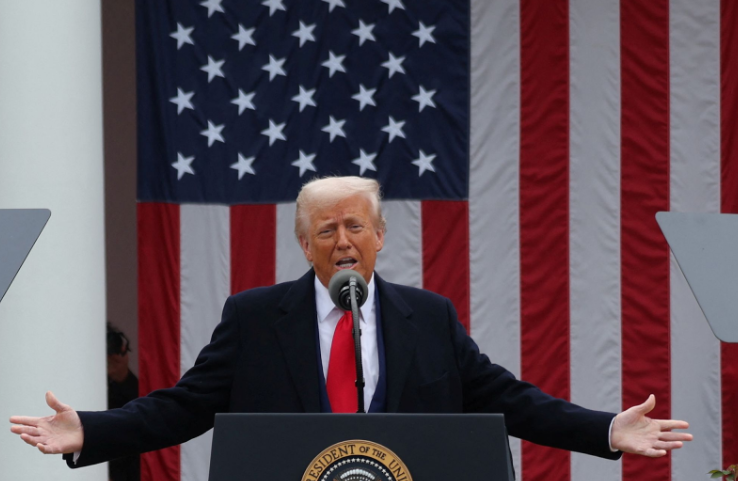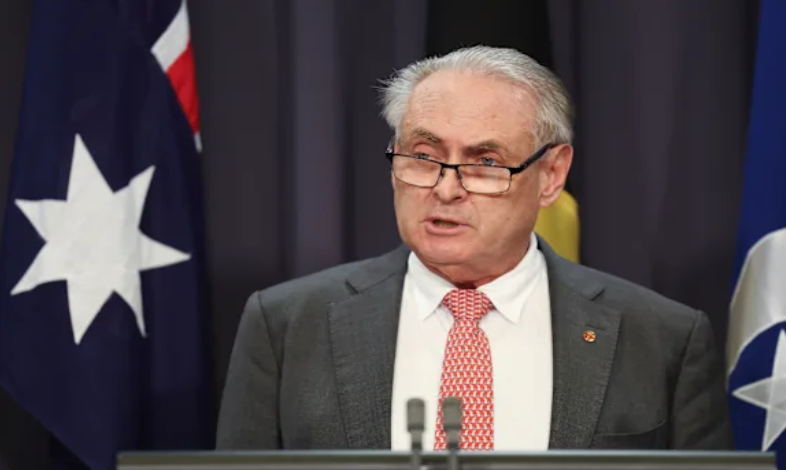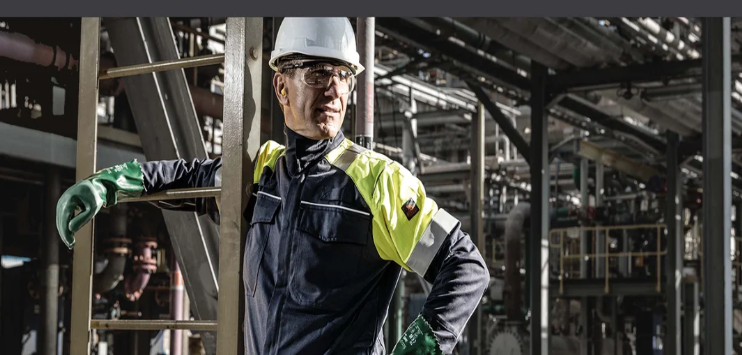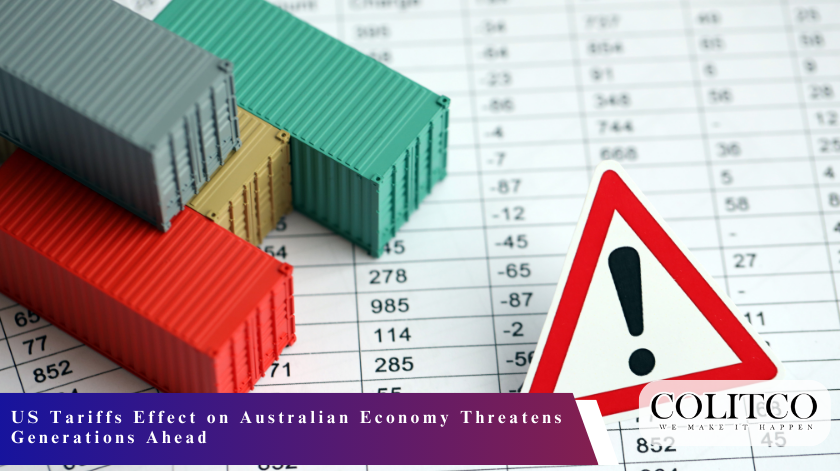The US tariffs’ effect on the Australian economy is emerging as a key challenge for policymakers. Trade Minister Don Farrell warned that existing US policies threaten businesses, consumers, and economic stability in Australia for the long term as Canberra focuses on its friendship with Washington.
US Tariffs’ Effect on Australian Economy Spreads Alarm
U.S. President Donald Trump, on 2 April 2025, announced draconian “Liberation Day” tariffs. The new rule imposed a 10 per cent minimum on most imports and increased levies on selected goods from 11 to 50 per cent.

President Donald Trump announced sweeping “Liberation Day” tariffs on 2 April 2025
Australia was immediately hit with harsh penalties. Steel and aluminum exports were hit with a 50 per cent tariff, and pharmaceutical products faced the threat of possible levies of up to 200 per cent. These measures departed from historic trade norms and brought new uncertainty to exporters.
Farrell Warns of the Long-Term Impact of Tariffs on Australia
Speaking to the Lowy Institute, Don Farrell said the longer-term implications of tariffs on Australia would be more than the ongoing trade war. He warned that global frameworks were trending toward economies of size versus common rules.

Trade Minister Don Farrell warned that U.S. tariffs could hurt Australia’s economy for generations
He further added that if Australia’s most important partners witnessed slower growth, the domestic economy would automatically be hurt. Farrell emphasized that prices for both industries and households would not be short-term but would be persistent for decades.
Strategic Diplomacy in a Complex Trade Environment
Despite this view, Farrell reaffirmed that the U.S. alliance remains at the center of Australian policy. Addressing the Australian Financial Review Asia Summit, he called maintaining good relations with Washington “a top priority.”
But he dismissed hopes of tariff relief, signalling to AFR that Trump was not going to ease restrictions. Farrell further said that sustained diplomatic efforts are needed, but Canberra shouldn’t expect immediate concessions.
US Tariffs’ Impact on Australian Economy Offset by Baseline Rate
The U.S. revised tariffs in the global economy in July 2025. Even though the majority of countries had their penalties increased, Australia maintained the 10 per cent baseline tariff rate. The move was termed as a diplomatic victory that came as a result of cautious Australian leaders negotiating.

Steel and aluminium exporters remain among the hardest hit by U.S. tariff penalties
Prime Minister Anthony Albanese mentioned during an interview with journalists that he wished the baseline would hold, while the government would continue to advocate for exemptions. This outcome provided short-term relief for most firms but not long-term assurance.
Analysts Balance Up Australia Trade War Effects
Mixed economic modeling forecasts an Australian trade war. Since only 5 per cent of Australian exports are destined for the U.S., direct trade exposure is minimal.
The Commonwealth Bank put GDP as low as 0.3 per cent lower over several years. But KPMG economist Brendan Rynne put the potential losses as high as $27 billion, or about 1 per cent of GDP. Both projections showed reduced growth and higher costs to consumers.
Canberra’s Broader Strategic Response to Tariffs
The government has moved to generate economic resilience. One of them is market diversification, and negotiations for trade with India and the European Union continue. Other trade missions have been launched as well in order to advance relations with Asia.
Regionally, the $15 billion National Reconstruction Fund has an emphasis on export-support lending, advanced manufacturing, and strategic minerals. Discussions are underway to introduce anti-dumping to shield industries exposed to international unfair pricing strategies.
Defence Cooperation and Trade Policy Remain Segregated
Officials insisted defence agreements, including AUKUS, are not being touched by trade negotiations. Farrell reiterated that security cooperation will continue regardless of trade disputes.
The position is intended to preserve stability in defence while leaving space for standalone trade negotiations. It is reflective of Canberra’s twin approach of national security and economic stability.
Reserve Bank Watches Over Long-Term Effect of Tariffs on Australia
The Reserve Bank of Australia reduced interest rates to 3.85 percent based on softer expectations for the growth of the global economy. Officials noted that the long-term impacts of tariffs on Australia include decreased investment and lower demand for exports.
Assistant Governor Sarah Hunter said tariffs had the potential to temporarily lower global prices for traded goods. However, she warned that uncertainty was holding back new investment and threatening long-term output growth. The RBA has indicated that further policy shifts were possible.
Productivity Commission Call for Domestic Tariff Cuts
The Productivity Commission called on the government to eliminate low-value tariffs that collect little revenue. It argued that tariffs increase business and consumer expenses and lead to excessive administration.
Some analyses proposed tariff disruption to divert capital in a way that yields modest yields. However, the commission called on the government to modernize its tariff regime to remain competitive in the global economy.
Also Read: Rick Davies’ Legacy and Supertramp’s Greatest Hits
Market Diversification as a Constant Priority
Economists recommend deepening trade relationships with economies aside from the US. Pacts with India and the EU are seen as being crucial in reducing dependence on the US tariffs’ effect on the Australian economy.
Industry lobbies reiterated constant diplomatic action and investment in innovation. Competitiveness building in priority sectors is seen as vital to protect Australia’s growth trajectory in the face of prolonged tariff disparities.
Looking Ahead: Australia Trade War Fallout Over Generations
Farrell’s warning represents the coming generations’ stakes. While Australia has thus far evaded deeper tariff punishment, the long-term impact of tariffs on Australia will be evident for years to come.
Australia must pursue three key strategies, according to experts:
- Sustained Washington and other like-minded partners’ diplomacy
- Increased diversification of export markets
- Investment in innovation and key sectors
These actions will determine how Australia is going to ride out the Australia trade war ramifications and adjust to a shifting world trade regime.
Frequently Asked Questions S Tariffs Effect (FAQs)
- What is the US tariffs effect on Australian economy in 2025?
The US tariffs effect on Australian economy includes higher costs for steel, aluminium, and pharmaceutical exports. It also creates uncertainty for businesses relying on stable international trade rules. - Which Australian exports are most affected by U.S. tariffs?
Steel and aluminium exports face a 50 per cent tariff. Pharmaceuticals could face much higher levies, while most goods remain under a 10 per cent baseline tariff. - What is the long-term impact of tariffs on Australia according to officials?
Trade Minister Don Farrell warned the long-term impact of tariffs on Australia could last for generations. He said costs to businesses and consumers may extend beyond the current trade cycle. - How much of Australia’s exports go to the United States?
About 5 per cent of Australia’s total exports are directed to the U.S. While exposure is limited, the effect of tariffs still weighs on GDP and business investment. - What are the estimated economic losses from U.S. tariffs?
Economists project GDP could fall by around 0.3 per cent over several years. Other forecasts, such as KPMG’s, estimate losses of up to $27 billion. - How is the Australian government responding to tariff challenges?
The government is pursuing new free trade agreements with the EU and India, expanding trade missions in Asia, and investing in critical industries through the $15 billion National Reconstruction Fund. - Are defence agreements affected by U.S. tariffs?
No. Officials confirmed that defence partnerships like AUKUS remain separate from trade disputes. National security cooperation continues unaffected by tariff negotiations. - What role does the Reserve Bank of Australia play in this issue?
The Reserve Bank has lowered interest rates to support the economy. It warned tariffs could slow global growth and reduce investment in Australian industries. - How do tariffs contribute to Australia trade war consequences?
The Australia trade war consequences include slower growth, weaker investment, and higher costs for consumers. Trade disruptions also create long-term uncertainty for exporters and investors. - What strategies are being used to reduce reliance on the U.S. market?
Australia is strengthening partnerships with India, the EU, and Asia. Diversifying markets and investing in innovation are seen as essential strategies to reduce exposure to U.S. tariff risks.













